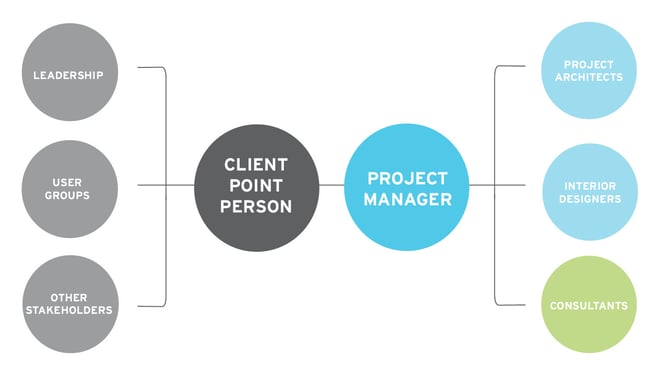Best Practices for Communicating on a Building Project

Successful building projects start by establishing expectations with everyone involved. With thousands of decisions ahead, it helps to create a clear communication plan and identify everyone’s roles and responsibilities.
We’ve guided various organizations through the architectural process—from universities with decades of experience to business owners undertaking a first building project. Although every project differs, we find most clients benefit from a few communication practices.
These practices include:
- Assigning a point person
- Establishing a regular rhythm with your design team
- Setting expectations for file storage and information sharing
- Considering a change management team
This article will discuss these practices in greater detail, preparing you to communicate with your design team and set expectations with your project’s stakeholders.
Assign a Point Person
A typical design team includes many professionals, including architects, engineers, and interior designers. Although you will interact with many people throughout the design process, your primary contact is your Project Manager. This individual leads the design team, manages schedules, and communicates with the client regularly.
To improve communication, we recommend assigning a point person who will act as the Project Manager’s primary contact for your organization. The point person will be responsible for maintaining communication with the design team, attending meetings, and relaying important information to your internal team.

The point person will communicate with the project manager.
Ideally, this person will have the institutional knowledge to identify groups that should participate in the design process. Some schools select the superintendent as the point person, while private companies may select someone with a managerial or employee experience role. Larger organizations, like universities, may have a dedicated facilities manager.
Regardless of this person’s role within your organization, they should be available to communicate with the design team. Although organizational leadership may have a final say on design decisions, they may not have the time to dedicate to the project. Instead, assign someone who can organize your internal team and relay information to leadership.
Establish a Regular Rhythm with Your Design Team
One of the point person’s primary responsibilities is to update your organization’s leadership on the project’s progress, schedule, and budget. A successful communication strategy provides the point person with all the necessary information.
To ensure success, the Project Manager should establish a regular communication rhythm. The point person should never have to wonder when they will hear from the design team next.
One approach is a regularly scheduled one-on-one meeting with the point person and the Project Manager. In this meeting, the two will discuss the project’s progress, upcoming meetings, and anything that has fallen off the radar. These updates can help with strategizing and ensure future meetings are as productive as possible.
Similarly, we recommend the point person and Project Manager coordinate important communication. If a group workshop is coming up, the Project Manager and point person should draft an invitation to ensure the workshop’s purpose is communicated clearly.
Consistent communication helps build trust and makes decision-making more efficient.
Set Expectations for File Storage and Information Sharing
Another important practice is to set expectations for file storage and information sharing. With many available means of communication, it helps to agree on a single approach.
While some organizations prefer email, others want to share files over a cloud program like SharePoint or Google Drive. Similarly, you should set expectations for day-to-day communication by thinking through questions like:
- Do you prefer phone calls or emails?
- Which platform is best for video calls?
- How would you like to receive meeting notes?
Reviewing these logistical concerns at the start of a project eases communication later in the process when decision-making picks up.
Consider a Change Management Team
Depending on your project, you may consider starting an internal change management team. Change management is a strategic way of addressing a transformation of an organization’s goals, processes, or technologies. The aim is to set expectations for new practices and minimize confusion.
A new space can change an organization’s operations. It may introduce new ways of working or improve collaboration between different teams. Creating a change management strategy can help your team identify with the new environment and adapt to new practices.
A change management team can handle many aspects of internal communication during the design process. They may coordinate moving, provide tours of the new facility, and train your team on new technology. Most importantly, they can work with the point person and the design team to answer your team’s questions and address their concerns.
Depending on your goals, change management can be handled by an internal team or a third-party consultant. Your design team may also help in this area. In any case, creating an internal strategy for managing change creates a smoother transition from one space to another.
Learn More About the Design Process
The design process can last months or years, depending on your project’s scope. At the same time, most projects involve a large group of stakeholders and many decisions impacting your long-term operations.
Creating a clear communication strategy helps manage this complexity. On any project, we recommend assigning a single point of contact to manage communication with the design team and relay information to your project’s stakeholders.
Regular meetings, project updates, and clear expectations surrounding information sharing minimize confusion later in the design process. We also recommend an internal communication strategy or a dedicated change management team to set expectations with your team.
Your design team will also recommend activities to engage your internal team and involve them in decision-making. These activities can include visioning workshops, empathy mapping, and visual listening activities. Learn more by reading about empathy-building activities in pre-design.